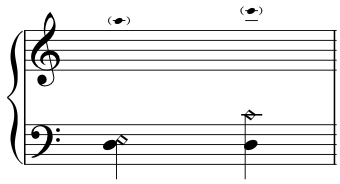Other partial harmonics
The 6th partial (double-octave + fifth harmonic) and the 7th partial (minor-seventh harmonic) can be produced on some of the longest strings on the harp. However, these harmonics are difficult to produce since the place where the finger has to pluck the string is very close to or even in between the tuning discs.
Octave, fifth, double-octave, major-third, double-octave + fifth, and minor-seventh harmonics on one string.
Production
When producing harmonics high on the string it is often better to pluck the string with the nail of the thumb or to use the nail of the second finger.
Sound
Both the double-octave + fifth and the minor-seventh harmonic are extremely soft.
Notation
The double-octave + fifth harmonic is notated with a little dimond placed a major-second above the fundamental. The harmonic sounds two octaves and a fifth higher than the fundamental.
The minor-seventh harmonic is is notated with a dimond placed a minor-seventh above the fundamental. The harmonic sounds two octaves and a minor seventh higher than the fundamental.
To avoid confusion it is helpful to write the sounding pitch in parentheses above the note the first time such harmonics occur.

Double-octave + fifth harmonic, minor-seventh harmonic.
Range
Only the lowest (longest) strings can be used to produce double-octave + fifth and minor seventh harmonics. Note, however, that it can depend on the type of harp and its size if their production is possible. The position of the pedals can also make a difference. Furthermore it is important to remember that all harmonics produced on the wire strings sound rather soft and their pitch can be quite undefined.

Range for other partial harmonics.